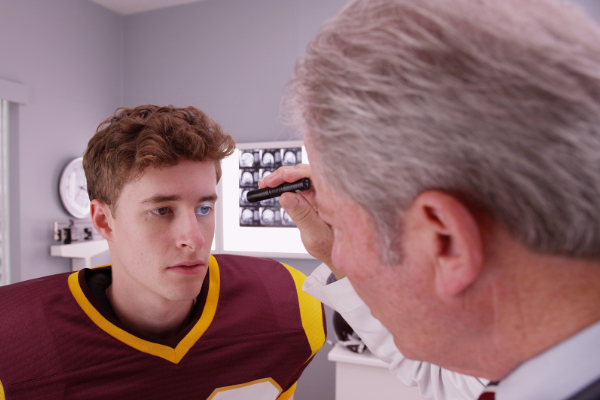The sound of helmets crashing together on a football field may evoke images of adrenaline-fueled action, but beneath this surface lies a chilling reality: players are facing long-term consequences from their time on the gridiron. With mounting evidence linking CTE to concussions and subconcussive impacts, questions arise about whether current helmet technology is truly effective in safeguarding athletes against these devastating outcomes. As we explore this complex and controversial topic, we must confront uncomfortable truths about player welfare and tackle difficult decisions regarding the future of America’s most beloved sport.

Football helmets have a fascinating history that dates back to the late 19th century when players would wear headgear made of leather and wool to protect themselves during intense matches. These early helmets were primitive by today’s standards, offering limited protection against concussions and head injuries. It wasn’t until the mid-20th century that the modern football helmet, featuring a hard shell and padded interior, was introduced.
However, even with advancements in helmet technology over the years, concerns about their effectiveness in preventing long-term brain damage persist. Studies have shown a correlation between repetitive head trauma suffered by football players and chronic traumatic encephalopathy (CTE), a degenerative brain disease that has led to devastating outcomes for many athletes. As researchers continue to explore ways to enhance helmet design and player safety, it remains crucial for the football community to address these pressing issues surrounding CTE and player well-being.

Football, once celebrated for its thrill and excitement, is now marred by a dark shadow — the rising concern over football-related head injuries. With the increasing focus on chronic traumatic encephalopathy (CTE) and its devastating effects on athletes, football fans and players alike are left grappling with the harsh reality of the sport. The prevalence of CTE among former NFL players has sparked alarm, prompting a radical shift in how we view the long-term impact of head injuries sustained on the field.
As research delves deeper into the link between repetitive head trauma and CTE, it’s becoming clear that traditional football helmets may not be offering adequate protection against these brain-damaging injuries. While advancements in helmet technology have been made, questions arise about whether they are truly effective in preventing concussions and reducing the risk of developing CTE. This growing skepticism brings to light a critical debate: Are football helmets failing athletes in safeguarding their long-term neurological health?

Helmet design in the world of sports, especially in football, has long been heralded as a crucial element in player safety. However, the limitations of traditional helmet designs have come under scrutiny in recent years due to the rise of chronic traumatic encephalopathy (CTE) among athletes. The current helmet technology primarily focuses on preventing skull fractures and severe head injuries but fails to address the rotational forces that can lead to brain trauma.
While advancements like added padding and improved shell materials provide some protection, the design still lacks efficient solutions to prevent concussions and other brain-related injuries. This gap highlights a critical need for innovative approaches to helmet design that consider not only impact absorption but also the mitigation of rotational forces that cause CTE. As more research emerges on the long-term effects of repetitive head impacts, it becomes increasingly clear that traditional helmets may be falling short in safeguarding athletes’ brain health effectively.

Research findings on Chronic Traumatic Encephalopathy (CTE) continue to shed light on the profound impact of repeated head injuries among athletes, particularly football players. Studies have demonstrated that CTE is not just limited to professional athletes but can also affect individuals who engage in high-impact sports at various levels. The neural degeneration associated with CTE has been linked to symptoms such as memory loss, mood disorders, and cognitive decline.
Furthermore, recent research has revealed that the accumulation of tau protein in the brain, which is a hallmark characteristic of CTE, may be triggered by subconcussive hits rather than just concussions. This highlights the insidious nature of the condition and emphasizes the importance of preventive measures in reducing overall head trauma exposure. As scientists delve deeper into understanding CTE pathology and risk factors, it becomes increasingly clear that addressing this issue requires a multidisciplinary approach involving medical professionals, sports organizations, and policymakers alike.
As the awareness of Chronic Traumatic Encephalopathy (CTE) continues to grow within the sports industry, it is evident that a crisis looms over athletes, particularly in contact sports like football. While helmets have long been seen as a primary protective gear against head injuries, there’s a mounting concern that they may not be doing enough to prevent CTE. The reality is that CTE is a complex and multifaceted issue that requires holistic solutions beyond just improving helmet technology.
Addressing the CTE crisis in sports entails a fundamental shift in how we approach player safety on and off the field. From stricter implementation of concussion protocols to investing in advanced brain imaging techniques for early detection, organizations and leagues must prioritize the mental health of their athletes. Furthermore, promoting education around proper tackling techniques and emphasizing player well-being over performance metrics can help mitigate the risks associated with repetitive head trauma. Ultimately, confronting the CTE crisis requires collaboration among players, coaches, medical professionals, and policymakers to create a sustainable culture of safety in sports.
Moving forward to protect athletes from the devastating effects of CTE is a moral imperative that cannot be overlooked. While advancements in technology have led to the development of helmets like the T11R90 football helmet, which boasts superior impact resistance, there is still much work to be done. Sports organizations, medical professionals, and equipment manufacturers need to collaborate and prioritize research into improving head protection.
Furthermore, educating athletes themselves on the risks associated with repetitive head injuries and promoting safer playing techniques can also contribute significantly towards minimizing the prevalence of CTE. Ultimately, safeguarding the well-being of athletes requires a multifaceted approach that goes beyond just relying on helmet technology. By fostering a culture of safety and prioritizing player welfare above all else, we can take proactive steps toward ensuring a healthier future for those who participate in contact sports.